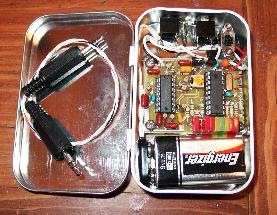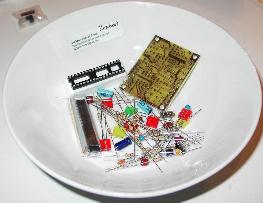N5ESE Builds the Jackson Harbor Son of Zero-Beat

(click on any picture to see larger version)

(click on any picture to see larger version)
Here is another "zerobeat" tuning aid, with a few more visual cues than my own zerobeat project. In this kit, costing about $25, and once supplied by Jackson Harbor Press and more recently by WB9KZY, a really unique approach to visual tuning is provided. Besides, it has lotsa lights, and who doesn't like lotsa blinking lights?
The "Son of Zerobeat" (as it is called), utilizes an audio bandpass filter and a PIC microcontroller as the central elements of the circuit. Audio from the headphones or speaker circuit of the receiver is filtered, then sampled by the PIC. The PIC acts like a crude signal processing engine, to provide frequency discrimination in 7 bands. For a single unknown tone in the audio, as when receiving a CW signal, the PIC will light one of the seven LEDs. If the received signal's frequency is within 10 Hz of the center frequency (selectable by the operator), the green center LED will illuminate. Otherwise, one of the other yellow or red LEDs will illuminate, indicating the direction (lower or higher pitch) and distance from the center frequency.

The center LED, which is green, will light when the received signal is within 10 Hz of the "center frequency". The yellow LEDs would light if we were off center by 30 Hz, with the left lighting if the pitch is lower, and the right lighting if the pitch is higher. For frequencies even lower and higher, the respective red LEDs would illuminate.
If we were to start with a very low pitch signal and slowly raise the pitch, we would see the leftmost red LED light up when we are about 110 Hz below the center frequency. As we continue to raise the pitch, the next LED would light, and the first would go out. Continuing, we would see each LED light (and go out) in succession until the green center LED lights, indicating we are within 10 Hz of our center frequency. As we continued raising the pitch, we would see the green go out and the yellow to the right of it light up, and so on until we reached the rightmost red LED, indicating we are more than 110 Hz above the center frequency.
In this way, then, we could use the Son of Zerobeat to help us visually tune our receiver to the correct pitch indicating "zerobeat" with the received signal. Now, when we transmit, we can be reasonably confident that we are close to the received signal's frequency, and within the remote operator's passband.
By the way, the center frequency can be set to any pitch in the range 400-1200 Hz. You do this by applying a clean strong signal (with the audio pitch you want "center" to be), then pushing a momentary pushbuitton (or shorting two points) briefly, whereupon the PIC microcontroller "memorizes" the new center frequency. I set most of my rigs for 600 Hz, so that's where I set the Son of Zerobeat.
The 8th LED is operated from a threshold detector, and can be seen to light in sync with the CW signal (provided that the signal is moderate to strong). It is affected only by amplitude, as set by a trimpot onboard the pc board, and is pretty much frequency insensitive.
Construction
Here's a picture of the kit before assembly:

Assembly is straightforward, and soldering up the PC Board takes between 1-2 hours, depending on your experience level. I decided to package mine in my favorite enclosure - what else - an Altoids tin. I wired the input so that I could route the received audio in on a stereo jack, and route it out on a stereo jack. Essdentially, I made a headphone "Y" cable, except I put it inside the Altoids tin, tapping the audio to go to the Son of Zerobeat board.
The PC Board is so small, there's plenty of room for a switch and a 9-Volt battery inside the Altoids tin. I mounted the slide switch (power switch) on small spacers I grabbed from the junk box. A small 3-conductor patch cable was homebrewed, to connect the Son of Zerobeat to the receiver, and fits easily inside the Altoids tin for transport. Headphones, then, connect to the second jack on the Altoids tin, providing receiver audio to the operator.
How's She Sail?
Hooking it up on the bench, we provided a signal generator to the input of the receiver, and connected the Son of Zerobeat to the headphone jack. Sweeping the signal generator pretty much confirmed that the Son of Zerobeat worked as advertised, and it was super-easy to adjust the received signal for the center tone.
The real test came when we took it to the field, and hooked the receiver up to a real antenna. The Son of Zerobeat does quite well on strong (S7+) signals that have no QRM within a few hundred hertz, but noise and QRM tend to make the lights flicker randomly, and one ends up tuning by ear for weak to moderate signals or signals on a noisy or crowded band.
Still, it's hard to beat those flickering LEDs - ooch! Did I say "beat"?
73,
Monty N5ESE
dit dididit dit